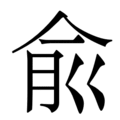Top Qs
Timeline
Chat
Perspective
兪
From Wiktionary, the free dictionary
Remove ads
See also: 俞
| ||||||||
Translingual
Han character
兪 (Kangxi radical 11, 入+7, 9 strokes, cangjie input 人一月女 (OMBV), four-corner 80221 or 80237, composition ⿱亼⿰月巜(T) or ⿱𠓛⿰⿵⺆⺀巜((GJK))
Derived characters
References
- Kangxi Dictionary: page 126, character 15
- Dai Kanwa Jiten: character 1437
- Hanyu Da Zidian (first edition): volume 1, page 155, character 5
- Unihan data for U+516A
Remove ads
Chinese
Glyph origin
In oracle bone script, it was likely a phono-semantic compound (形聲 / 形声): semantic 凡 + phonetic inverted 由 (OC *lɯw), hence a form vaguely similar to 甲. It's also possible that the phonetic component is instead an ancient form of 鏃 (OC *ʔsoːɡ).
In bronze inscriptions, 凡 corrupted into 舟, and the bottom-right subcomponent of 甲 gradually corrupted into two lines 巜 (now written 刂). The upper-right subcomponent (vaguely similar to 口) was eventually stylized as (亼) and moved to the top of the character in bamboo slips. Eventually, 舟 was further corrupted into 月, arriving at the modern form 俞.
Definitions
| For pronunciation and definitions of 兪 – see 俞 (“to hollow a tree to make a boat; yes; indeed; etc.”). (This character is a variant form of 俞). |
Remove ads
Japanese
Kanji
兪
- This term needs a translation to English. Please help out and add a translation, then remove the text
{{rfdef}}.
Readings
Korean
Hanja
兪 • (yu) (hangeul 유, revised yu, McCune–Reischauer yu)
- This term needs a translation to English. Please help out and add a translation, then remove the text
{{rfdef}}.
Wikiwand - on
Seamless Wikipedia browsing. On steroids.
Remove ads




